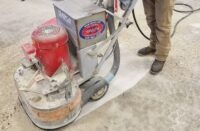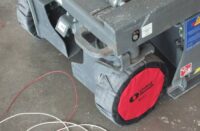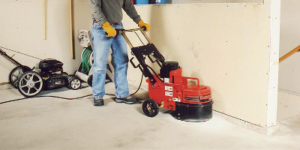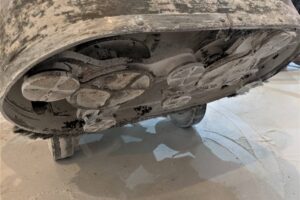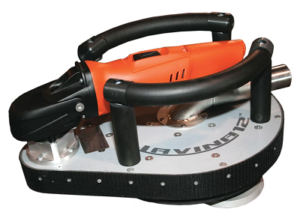How long is a set of diamonds supposed to last? Or more to the point, what kind of square footage can I expect out of a set of diamonds?
First, let’s start with one important point — the operator must perfectly match the diamond bond to the hardness of the concrete. A perfect match will produce a complete scratch pattern on the concrete without eating through your diamonds and profit margin.
Ignoring this primal rule is asking for trouble. Inevitably, if the diamond bond is softer than the hardness of the concrete, the diamonds will wear out quickly. If the diamond bond is harder than the concrete, the diamonds will resist cutting into the concrete, essentially producing little wear and a negligible and uneven scratch pattern.
The hardness of concrete also impacts diamonds’ production and effectiveness because of the kind of dust that is produced during the cutting process. Hard concrete tends to produce ultrafine talcum powder dust. This dust is very nonabrasive — it does not wear the bond of the diamond segment sufficiently. As a result, the diamond grit barely becomes exposed, so it grinds even finer powdery dust. Soon, the segment ceases to grind and the segments may even get hot and glaze over. The term “glazing over” simply refers to the metal matrix or bond not eroding and exposing new diamonds. When this starts to occur, a softer-bond diamond should be used to avoid this situation.
The opposite is true regarding soft concrete. It produces very soft, gritty, sandy dust that is aggressive against the bond, eroding it and constantly exposing diamonds, and in this case a harder-bond diamond should be chosen.
Luckily most diamond manufacturers have caught on and now make several metal bonds for each grit.
Gauging hardness on the job
So how does one attempt to answer the diamond life question in the field? The first step is to begin with a quick analysis of the concrete slab. One method is scratching it using a Mohs test kit to get a feel for which diamond bond should be used to start the job. The first few minutes of grinding with the initially selected diamond bond will help determine the validity of the test results. Once grinding begins, too much dust after a few passes and the bond is too soft. Hardly any dust, and the bond is too hard.
The grinding sweet spot is when the grinder is producing a fair amount of dust as it passes and cuts the concrete, the concrete that is revealed is uniform and lighter in color, and the operator is able to move forward at a steady pace.
A crucial note for all business owners about grinding in the sweet spot with the correct bond — that’s the point where you have hit the peak of the Diamond Cost vs. Labor Cost graph, both financially and by time spent grinding.
The makings of a quality diamond
Now, the rocket science part of the question! Not all diamond manufacturing is equal. The technology for developing a bond is complex, with many minerals and elements (such as cobalt, copper and nickel, to name a few) mixed and matched in specific ratios that must be precisely followed as the diamond bond is produced.
In addition, the type, quality, size, concentration and structure of the diamond itself is a factor. The diamond is either a natural diamond geologically mined or a synthetic diamond created in an artificial process.
The quality of diamonds is factored into the bond as it is directly linked to the application that it is intended for. For example, a manufacturer may choose to use a lower-quality diamond in a softer bond to release new unused diamonds at a constant rate. The lower-quality diamonds will splinter and create new cutting edges more easily than a higher-quality diamond.
Manufacturers must maintain strict control of diamond mesh size, more commonly known as grit size, and in addition, they must ensure that the concentration of that mesh is consistent throughout the bond. The structure or shape of the diamond is important, since diamonds can have many sides and a multitude of edges, which cut into the substrate.
The ratio of specific diamonds within a grit segment as well as the ratio of natural to synthetic diamond grit will also determine its effectiveness. For example, when manufacturing a premium 30/40 grit segment, the manufacturer determines the concentration of diamonds and the ratios between 30 grit, 40 grit and the small amount of either a lower or higher grit of diamonds thrown into the mix.
Now, add the manner in which the bond is manufactured, whether it is hot- or cold-sintered and at what temperature and for how long, and you soon begin to realize how it is that each manufacturer approaches the manufacturing of diamonds differently. (Note: Sintering is the process of pressing or compacting the powdered materials — the diamond bond — into a desired shape and then heating the compressed material to bond the material and essentially create a solid — the metal bond segment.)
Let’s now look at size. A larger segment will last longer and therefore cover more square footage than a smaller segment, given that all other things are equal. When referring to size, we use the length, width and height or other measurements to help determine volume. For example, a standard rectangular segment that is 40 millimeters long by 10 millimeters wide and 10 millimeters in height has a volume of material that equals 4,000 cubic millimeters. Now let’s take a segment that is round with the dimensions of 24 millimeters in diameter and 13 millimeters in height. This segment is about 5,880 cubic millimeters in volume and is therefore 47 percent larger than the rectangular segment. So if all things are equal, the round segment will provide 47 percent more square feet of production than the rectangular segment.
Other factors
An external factor to consider when evaluating diamond life and effectiveness is the condition of the diamond grinder. A grinder that is in good condition will not abuse the diamonds as they are used. Equipment not maintained or worn or broken parts not replaced will cause diamonds to wear unevenly or excessively.
In addition, operator experience is vital to maximizing tool life, as one must be experienced in “reading” the diamonds as they grind and cut the concrete.
As you begin to understand and appreciate the complexity behind the research, development and manufacturing of diamond segments, you become able to ask the right questions in order to arrive at the answers that will give you the most bang for your diamond buck.
I would like to thank Ron Yagur of Dynamic Diamond Tooling for his technical expertise and contribution to this article.
